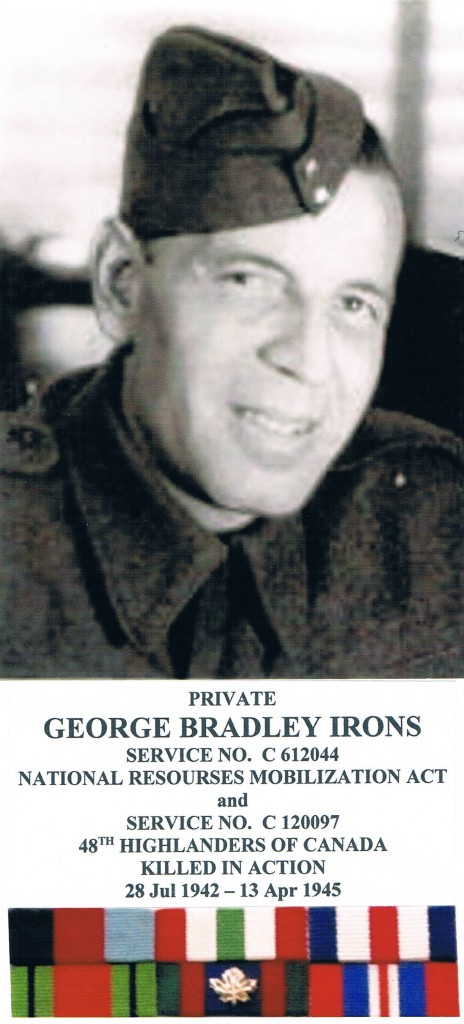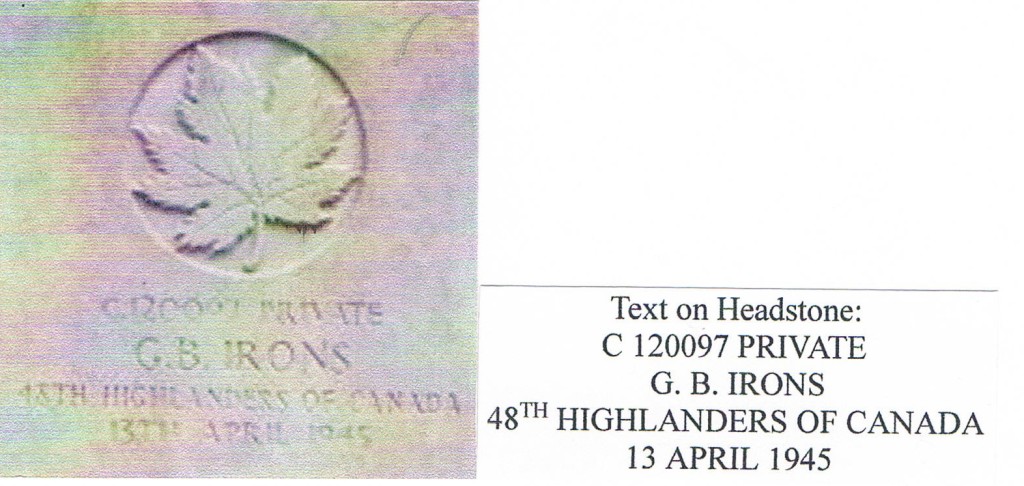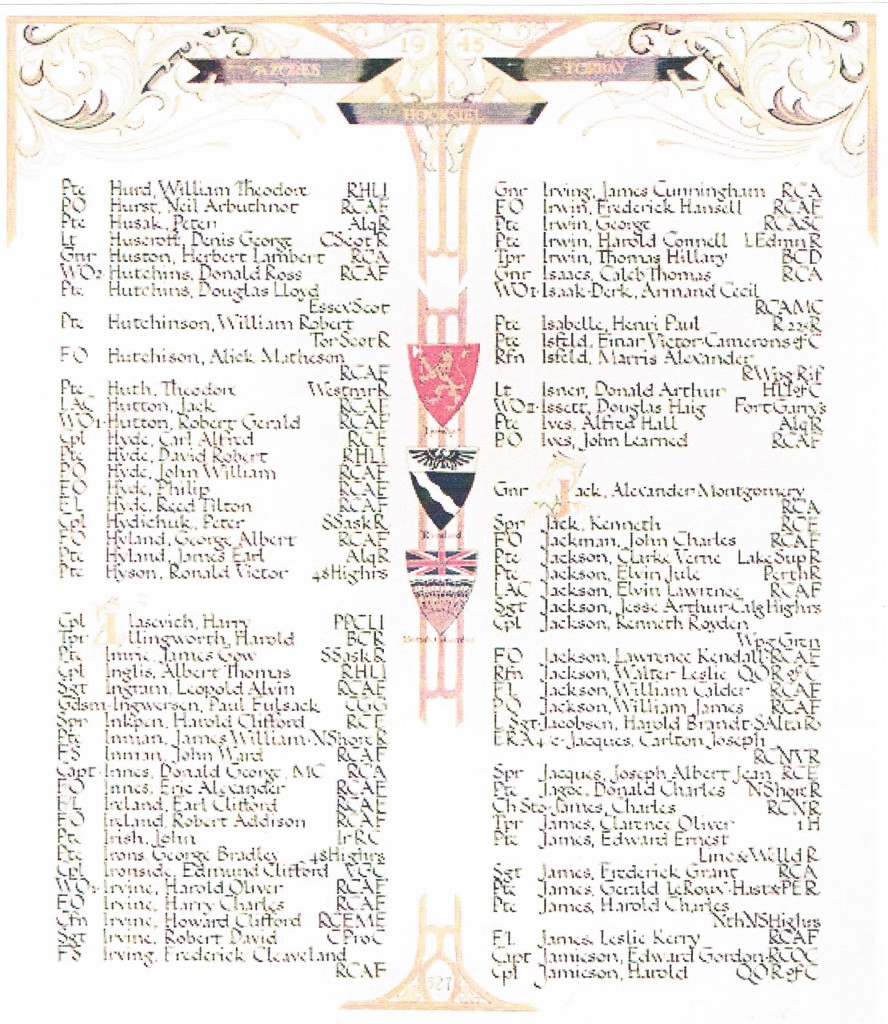
MILITARY HISTORY
Private George Bradley Irons – C 612044 — NRMA (World War II)
George Bradley Irons was 32 years, 18 days old when, as a single man, he enrolled under the Militia Act; National Resources Mobilization Act (NRMA) 1940, in Kingston Ontario on July 28, 1942. His NRMA Serial Number of Notice of Call was C-36952. George Bradley, a North American Native Indian, resided at Curve Lake, Ontario and was born in Ontario on July 16, 1910. He was 5′ 6½” tall, weighed 162 pounds, brown eyes, dark hair and gave his occupation as a labourer. He indicated that he had no previous military experience. George Bradley’s next-of-kin was his mother Elizabeth Irons, living at Curve Lake. On July 28, 1942 he was assigned the rank of Private; given Regimental Number C 612044 and enrolled in the NRMA at Clearing Depot (CD) No 3 in Kingston, Ontario. His Medical Category of A-1 was determined at No 3A District Depot (DD), Kingston. On the same date Private (Pte) Irons was attached to No 3A DD and for all purposes to “E” Wing. One week later Pte Irons ceased to be attached to No 3A DD and is struck-off-strength from CD No 3 having enlisted in the Active Force.
Private George Bradley Irons – C 120097 — ACTIVE SERVICE (World War II)
George Bradley Irons was 33 years (date of birth changed), 3 weeks and 5 days old when, as a single man, he enlisted in Kingston Ontario August 5, 1942 in the Active Force with the Canadian Infantry Corps (CIC). George Bradley resided at Curve Lake, Ontario and was born in Ontario on July 16, 1909. He was 5′ 8¼” tall*, weighed 157 pounds, brown eyes, dark hair, and gave his trade as lumbering. George Bradley’s next-of-kin was his mother Elizabeth Irons, living at Curve Lake. He was promised a job after discharge by Mr. R. Reid of Bobcaygeon, Ontario. He indicated that he had previous military experience within the National Resources Mobilization Act from July 28, 1942 to August 4, 1942 and his Regimental Number was C 612044. George Bradley’s Medical Examination was done in Kingston. On August 5, 1942 he was assigned the rank of Private; given Regimental Number C 120097 and was taken-on-strength to No 3A District Depot (DD) for Infantry (Machine Gun) Reinforcements (Inf (MG) Reinf). August 14, 1942 Pte Irons was struck-off-strength from No 3A DD Kingston on transfer to No 31 Canadian Army (Basic) Training Centre [CA(B)TC]. August 15, 1942 he was attached to CA(B)TC, Cornwall, Ontario from DD 3A, Kingston for all purposes for Inf (MG) Reinf Basic Training. * Probably had his shoes on for this determination.
After 2½ months of training, on October 31, 1942, Pte Irons ceased to be attached to CA(B)TC Cornwall on transfer to A-17 Advance Training Centre (ATC) – Inf MG at Three Rivers, Québec. November 1, 1942 Pte Irons was taken-on-strength as a Cameron Highlanders of Ottawa Reinforcement from No 31 CA(B)TC. After 2 months of training, on January 1, 1943, Pte Irons was authorized to receive $1.40 per day pay and just 4 days later, on January 4, 1943, he was authorized to receive $1.50 per day pay. February 20, 1943 Pte Irons was granted 13 days Furlough to March 4, 1943 inclusive and a Travel Warrant. On March 26, after a total of 3½ months advanced training he was struck-off-strength from the Canadian Machine Gun Training Centre (CMGTC) at A-17 ATC and the Canadian Army Active Force [CA(AF)] – Canada.
On March 27, 1943 Pte Irons embarked Halifax, Nova Scotia for the United Kingdom (UK) and was taken-on-strength to the CA(AF) – Overseas on March 28, 1943. April 4, 1943 he disembarked the UK and on April 5, 1943 he was taken-on-strength to No 5 Canadian Infantry Reinforcement Unit (CIRU), UK and granted the rate of pay of $1.50 per day. On April 7, 1943, after being interviewed it was suggested that he be employed in Mountain Warfare, Vicker’s Machine Gun and General Duties. July 26, 1943 Pte Irons was granted 9 days Privileged Leave, with meal allowance, to August 3, 1943. After about 6½ months with No 5 CIRU; on October 26, 1943 Pte Irons was struck-off-strength from No 5 CIRU to “HOT DOG”*. October 27, 1943 he was struck-off-strength from CA (UK) on embarkation to Italy and October 28, 1943 he was taken-on-strength to CA (Mediterranean), 4th Battalion, Hastings & Prince Edward Regiment (H&PER). November 9, 1943 Pte Irons disembarked Italy. December 24, 1943 he was posted to the X-3 List, still with the H&PER in the Field. After about a month in action with the H&PER, on February 3, 1944, Pte Irons was struck-off-strength from the 4th Bn H&PER to the 48th Highlanders of Canada (H of C) and February 4, 1944 he was taken-on-strength to the 48th H of C from the 4th Bn H&PER. *No explanation was found, meaning is unknown.
On May 17, 1944 the 48th H of C lost touch with the RCR and H&PER. For the rest of the day the 48th H of C moved forward, encountering less and less German defensive positions as they went. As night fell, on May 17, 1944, after a successful advance up the Liri Valley the 48th H of C were attacked in the darkness. A little over three months after joining the 48th H of C Pte Irons was wounded on this day and initially admitted to No 4 Canadian Field Ambulance (CFA) with shell wounds; left hand and left lower leg. On May 17, 1944 he was admitted to No 3 Canadian General Hospital (CGH) and then transferred to No 14 CGH.
This is a recounting of the events leading up to May 17, 1944, the day when Private Irons was wounded in Italy, in the Liri Valley.
On May 15, 1944, following the breakout, through the Gustav Line, the 1st Canadian Corps was charged with pressing the attack, up the Liri Valley, towards the Hitler Line. The 48th Highlanders of Canada (H of C) were called forward, from their reserve position. For the attack, the 48th H of C would take a position between the Royal Canadian Regiment (RCR) on their left, and the Hastings and Prince Edward Regiment (H&PER) on their right.
The Officers of the 48th H of C had their concerns about the plan. First of all, they felt the plan had been put together too quickly, leaving no time to reconnoiter the terrain or German defenses. Next, unrecognized in the plan was the Spella Bassa River, a tributary of the Liri River. In the view of the battle planners the River represented nothing more than an insignificant physical feature. Although, in some cases, the river was little more than a narrow creek, in other areas it was wide, deep, and with steep banks making it a natural tank barrier. It didn’t play a major role with the 48th H of C but it did with the RCR. This oversight was probably due to the unreliability of the maps available of the region and lack of detail shown. This problem, with available maps, had plagued Allied Operations, all through Italy.
The Canadians would go into battle, the morning of May 17, 1944, with only the vaguest knowledge of the terrain and possible German defenses in front of them. In addition, there would be little artillery support and no engineers, on hand, to bridge the river so that tanks could cross. In-spite of these issues, the attack went ahead, at first light, as planned.
The three Regiments, crossed the Spella Bassa River, and almost immediately, they ran into stiff opposition, but through a series of flanking maneuvers, the 48th H of C made good progress. Approximately, midmorning the 48th were in the process of consolidating their gains, after a successful advance up the Liri Valley. That night, suddenly, out of the darkness, enemy tracked vehicles attacked. In close combat, using bazookas, mortars, and small arms fire, the German attack was beaten back, with a number of the tracked vehicles destroyed. It was on this day that Private Irons was wounded. (Research courtesy of Mr. Ted Morin)
On May 18, 1944 Pte Irons was transferred to the X-3 List from the 48th H of C. May 25, 1944 he was transferred to No 1 Canadian General Hospital and on May 27, 1944 Pte Irons was discharged to the X-3 List. May 28, 1944 he was posted to the X-4 List (3rd Bn) from the X-3 List. On July 22, 1944 Pte Irons was posted from the X-4 List (3rd Bn) to the X-10 List on attachment to O2E Allied Armies Italy (AAI).
On September 13, 1944 he was posted from the X-10 List to the X-4 List (3rd Bn), Canadian/Area Headquarters (C/AH) to 2nd Echelon in the Field. September 21, 1944 Pte Irons was struck-off-strength from the X List (4 Bn) to the 48th H of C and was taken-on-strength to the 48th H of C on September 22 1944. Over the next six month Pte Irons would be in action with the AAI as a member of the 48th Highlanders of Canada. In total he would serve for 10 months with the AAI.
On March 11, 1945 Pte Irons was struck-off-strength from the Canadian Army, Central Mediterranean Force on embarkation Italy for France; he disembarked France on March 13, 1945. On March 29, 1945 he was granted Privileged Leave with a Travel Warrant to April 4, 1945. Nine days later, April 13, 1945 Pte Irons was killed-in-action in Holland; he was buried in the WILP, Holland Cemetery.
This is a recounting of the events leading up to April 13, 1945, the day when Private Irons was killed in Holland. Operation Cannonshot was launched April 11, 1945 at 15:30 pm and it seemingly caught the Germans by surprise when the 1st Canadian Division attacked, not the 3rd Canadian Division that the Germans had anticipated. Apparently, the Germans didn’t realize the 1st Canadian Division was in the area. Part of the plan was to have the 1st Canadian Infantry Brigade, comprised of the Royal Canadian Regiment (RCR), the 48th Highlanders of Canada (H of C), and the Hastings and Prince Edward Regiment (H&PER), to cross the Ijssel River, and to advance along the axis of the Deventer – Apeldoorn railway towards the airfield at Teuge.
On April 13, 1945, before first light, the 48th H&PER entered the outskirts of the village of Twello. As the 48th H&PER moved through the village, resistance was at times sporadic and sometimes fierce, as the Unit came up against the 953 Grenadiers of the 361 Volksgrenadier Division. With it’s Tactical Headquarters set up in the village railway station, the 48th H&PER, accompanied by tanks from the 1st Canadian Hussars, were ordered to secure a crossroads near the Teuge airfield. Fighting now became fierce as the Germans recovered from their initial surprise. The pace of the advance, by the 48th H&PER, seemed impossibly fast, no mop-up, or pickets, just move forward. In recognition of the fact many felt they were in the final days of the War, in an effort to minimize unnecessary causalities, by-passing German resistance became the order of the day. By nightfall, the Unit was in the vicinity of Achterhoek, just east of Apeldoorn. According to the Holden Cemetery Records, 5 members of the 48th Highlanders of Canada were killed in the Liberation of Twello, one of which was Private George Bradley Irons. (Research courtesy of Mr. Ted Morin)
May 5, 1945 the Canadian Message was dispatched to Pte Irons mother (next-of-kin) with information of George’s demise and burial reference. May 29, 1945 the Royal Message was dispatched to Pte Irons mother (next-of-kin). At a later date Private Irons was exhumed and reburied in the Holten Canadian Military Cemetery, Holten Holland. Grave 6, Row C, Plot 1.
Pte Irons had left a $100.00 Victory Bond (related by his mother) and had $1,329.00 held as savings by the Department of Indian Affairs. Although not in his Military File, he probably had been sending his mother $20.00 monthly on assignment.
Pte Irons was awarded the following medals:
1939 – 45 Star;
Italy Star;
France and Germany Star;
Defence Medal;
Canadian Volunteer Service Medal with Bar; and
War Medal, 1939 – 45.
He was also awarded War Service Badge – Class “A”
George Bradley Irons served for 8 months in Canada, 6 months and 3 weeks in the United Kingdom, 1 year and 4 months in Italy and 1 month in the Western European Theatre of War for a total time of 2 years, 8 months and 2 weeks (including travel time).
“Pte. Irons, George Bradley 48th Highlanders” is inscribed in the BOOK OF REMEMBRANCE 1945 on page 527.
Private Irons’ Memorial Cross was sent to Mrs. Elizabeth Irons, Curve Lake, Ontario in 1945. The Memorial Bar was sent to Mrs. Elizabeth Irons c/o Superintendent, Rice & Mud Lakes Indian Agency, 385 Water Street, Peterborough, Ontario.
An excerpt from an article in McLean’s magazine by Barbara Amiel, September 1996:
The military is the single calling in the world with job specifications that include a commitment to die for your nation. What could be more honorable?


PERSONAL HISTORY
GEORGE BRADLEY IRONS
George Bradley was born July 16, 1909 at Curve Lake, Ontario. George Bradley enjoyed hunting and fishing, he played baseball (pitcher) and hockey (defence) plus he played a bass-horn. In 1927, when he was 18 years old, he fractured his left femur and left ankle; then in 1931 he had an appendectomy. George Bradley spoke English and Ojibwe, he completed Grade 7 before going to work.
During the Summers George Bradley’s main work was as a guide for tourists. He also worked for D. Whetung as a labourer in the General Store for 10 years. In 1929 he works for six months as a driller on highway construction for Crawley and McCracken of Burleigh Falls, Ontario. He also had limited farming experience harvesting in Central Ontario. During the Winters George Bradley worked in Lumbering Camps as a Copper and Sawyer (axe and cross-cut saw work) from 1926 to 1942 for Mr. R. Reid of Bobcaygeon, Ontario.
Prior to enlisting George Bradley provided $20.00 monthly to his father to help out with expenses.
THE GEORGE BRADLEY IRONS FAMILY OF CURVE LAKE
George Bradley’s paternal grandfather, Joseph Irons was born about 1847 in Ontario married Margaret, born about 1855 and according to the 1901 Census of the Mud Lake Indian Reserve (Curve Lake), Smith Township, Ontario; Joseph and Margaret had six children: Stephen, born about 1875; Joseph Wesley, born about 1882 John, born about 1890, Eliza Fawn, born about 1886, – married John George February 23, 1906 and Laura, born about 1894. Also there was a step-son, John James, born about 1878.
George Bradley’s parents, Joseph Wesley and Elizabeth Irons (Irish) were married on the Mud Lake Indian Reserve (Curve Lake), Ontario on May 24, 1907. Wesley and Elizabeth had two sons, Sidney (in the Army too) and George Bradley, both born at Curve Lake. According to the 1911 Census there were also two step-children; John and Louisa McCue, in the family.
NOTE:
The Irons family descended from the Ojibwe (also Ojibwa), Anishinaabe, or Chippewa who are one of the largest groups of Native American and First Nations Peoples on the North American continent. In Canada, they are the second-largest population among First Nations, surpassed only by the Cree. Ojibwe who were originally located along the Mississagi River and made their way to southern Ontario are known as the Mississaugas to which the people of Curve Lake are members.
(From Wikipedia, the free encyclopedia)